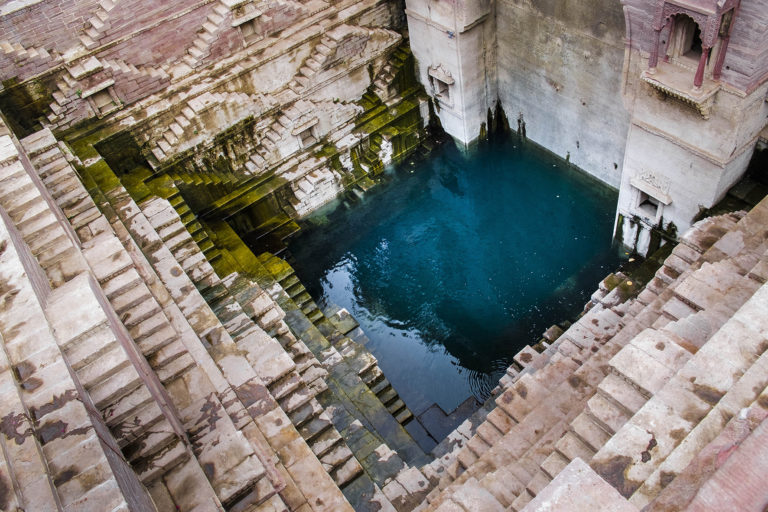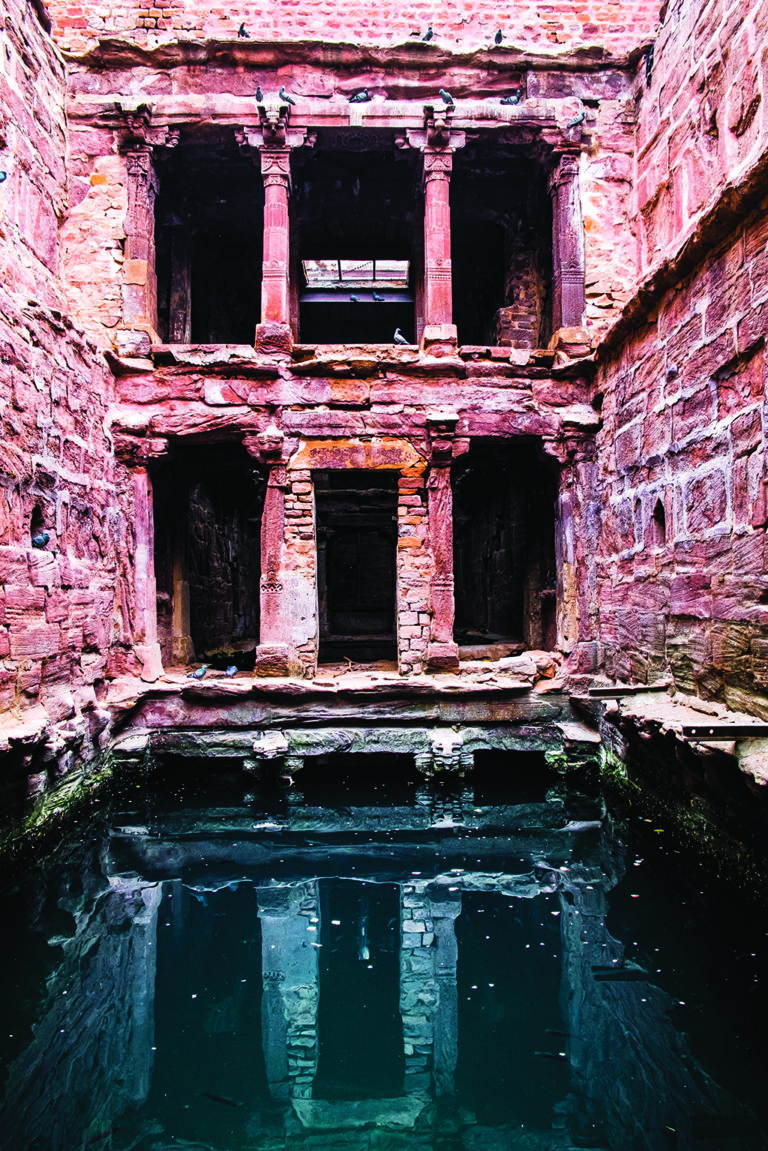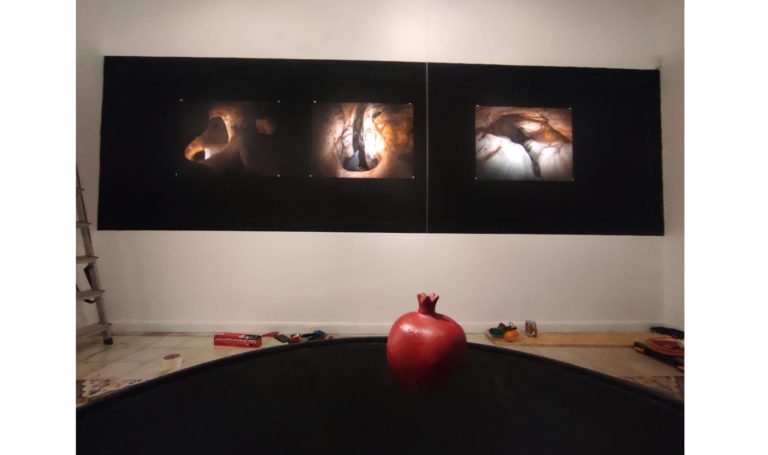
על המסך שלי נחתה מצגת שובת לב עם דימויים של ״בארות-מדרגות״ [stepwells] בהודו – יצירות מופת ארכיטקטוניות עם מדרגות היורדות אל בריכות מים הנמצאות עמוק מתחת לפני האדמה, ואז שוב עולות, בתצורות דמויות Escher. הן נבנו לפני מאות שנים, בעיקר באזורים המערביים הצחיחים של הודו באדמה התחוחה והחולית, ואפשרו לאוכלוסיה המקומית להגיע למפלס המים הנמוך מאוד בחודשים היבשים של החורף, אך עולה באופן דרמטי עם מונסוני הקיץ.
המדרגות הללו היורדות אל מי התהום הציפו את הדמיון שלי אם כי עדיין לא הבנתי מדוע. מעבר לעובדה שראיתי את בארות המדרגות כתצורות ויזואליות מדהימות מבחינה ארכיטקטונית, הרגשתי שהמדרגות האלה אל תוך האדמה מעוררות בי משהו הרבה הרבה יותר עמוק.
יצאתי לצלם בארות מדרגות בשני טיולים בהודו, ברג׳סטאן-גוג׳ראט ובדלהי. התברר שנדרשה לא מעט עבודת בילוש כדי לאתר את רוב הבארות, ואפילו נהגי הריקשה התקשו לברר זאת. בניגוד לרבים מאוצרות האדריכלות של הודו, הן לא מופיעות על מפת התיירות, ורבות מהן לא עמדו בפגעי הזמן. ובכל זאת, הצלחתי למצוא ולצלם למעלה מעשרים בארות מדרגות.
באי הקריבי הצחיח שבו גדלתי, מפלס מי התהום היה תמיד נמוך – לא הייתה לנו עונת מונסונים. משאבות המונעות על ידי רוח היו נפוצות בבארות, וצריך היה לשמור על כל טיפת גשם על ידי סכרים, מיכלים ובורות מים. היו גם pos di pia – ״בארות רגל״ – משטחים משופעים שאפשרו לרדת אל מי התהום. לאחר ששיתפתי את התמונות ההודיות שלי, נאמר לי שכמה מ״בארות הרגל״ הללו נבנו גם הן עם מדרגות, אלא שהפאר הארכיטקטוני של המונומנטים ההודיים עולה בהרבה על הפשטות של אותן מדרגות שימושיות למים. בביקורי הבא בקורסאו, יצאתי לצלם את המבנים הפחות ידועים של האי, שחוזרים אחורה אל תקופת העבדות העגומה שלו.
אין ספק, שיש אלמנט נשי בבאר המדרגות. היא לא מקרינה את עצמה לאוויר, לא ניתן לראות אותה מרחוק, כמו פירמידות ומגדלים פאליים – אנדרטאות שהוקמו ברובן על ידי שליטים גברים. באר המדרגות דומה יותר לפירמידת מדרגות הפוכה, אלא שנפחה מורכב מאוויר – חלל פנימי, לא ״משהו שניתן לראות״. היא לא תופסת מקום, להיפך, הוא מייצרת מקום ומאפשרת למפגשים וטקסים חברתיים להתקיים על מדרגותיה, כפי שעשו ועדיין עושים בהודו.
חשוב לציין שעשרים וחמישה אחוז מהשליטים והאנשים העשירים בהודו ההיסטורית שהזמינו בארות מדרגות לטובת הציבור, כאקט של חסד, היו נשים. רבות מהבארות הללו הוקדשו לאלה דורגה המזוהה עם הגנה ואמהות, כמו גם עם ההרס שעשוי להיות נחוץ לפני הבריאה. באר המדרגות הוא גם מקום של נשים במובן המילולי – שכן נשים הן אלו שמביאות מים בחברות מסורתיות רבות. אין ספק שנשיאת דליים כבדים של מים במעלה המדרגות הללו כרוכה במאמץ גדול מאד, אבל הביתנים המוצלים במדרגות, המאפשרים מנוחה ומפגשים חברתיים ושוברים את שגרת היומיום המפרכת של הנשים, זוכים להערכה רבה.
כסטודנטית לשעבר לאדריכלות, תמיד התעניינתי פחות באיכויות החזותיות של הבניין מאשר במימדיו התחושתיים והקינאסתטיים – באופן שאת חווה את החלל בכל החושים, לא רק בעיניים. אני שואלת איך הסביבה הבנויה מזמינה אותך לנוע בתוכה; אילו תחושות עדינות היא מעוררת כשאת הולכת במרחביה; אילו דימויים ארכיטיפים היא מעוררת. ובמיוחד, איך היא מחוללת בך שינוי עמוק – בדומה לטקס חניכה או עלייה לרגל.
לכן, היה לי חשוב לרדת פיזית אל תוך בארות המדרגות, לחוש את החלל האדריכלי מבפנים, ולחוות אותו כפי שהוא נועד להיחוות מעבר למימד הוויזואלי. כשהתקרבתי אל המים, במדרגות החלקלקות לעתים, הבנתי שהמדרגות ממשיכות עמוק למטה אל מתחת לפני המים, אל תוך הלא נודע, אל תוך עולם הרפאים.
לעתים קרובות, אי אפשר היה לרדת, לא רק בגלל ההזנחה וערימות האשפה, אלא בגלל שהבארות היו מגודרות ונעולות. הסיבות – או הרציונליזציות – להיותם בלתי נגישות למבקרים פרטו על הפחדים הראשוניים מהבורות האלה באדמה: שני זוגות האסורים לחיתון התאבדו בקפיצה אל מותם באחד מהם; סיפרו שילדים טבעו באחרים; או שהמקום היה ״שורץ נחשים ועקרבים״. הבריטים, בתקופת שלטונם הממושך בהודו, אטמו רבים מבארות המדרגות מסיבות היגייניות, כביכול, וגרמו למבנים המפוארים הללו להפוך למוזנחים ובלתי ניתנים לשימוש, ובעיקר להישכח.
הדימויים הארכיטיפיים שמעוררות בארות המדרגות, בהודו וגם בקורסאו, מזכירים מסע עמוק אל תוך הלא מודע. דימויים אלו נחקרו על ידי יונג ואותם בוחן הפילוסוף גסטון באשלאר בספרו ״הפואטיקה של החלל״. ספר זה העניק לי השראה לכתיבת ספרי: ״בית ללא דלתות״, שבו האלטר-אגו שלי בת השתים-עשרה, הולכת לחפש סודות משפחתיים אפלים במרתף ביתה הישן, שהופך למערה המובילה אותה לים תת-קרקעי קסום. דימויים שחולקים אם ובנה, מופיעים בתערוכה המהפנטת של איתמר מנדס-פלור בבורות המים של בית הנסן.
עם המדרגת שלהן, החודרות עמוק אל תוך האדמה, בארות המדרגות מעלות באוב את הירידה לשאול: אורפיאוס שירד לממלכת המתים; דמויות מיתולוגיות אחרות, כמו למשל, האלה המסופוטמית איננה/אישתר, שבבכל צעד בירידתה למטה התקלפה שכבה נוספת מהלבוש המלכותי שלה, מהזהויות הישנות שלה – כמו בתהליך חניכה – עד שנותרה עירומה לגמרי. ברבות מהמסורות הללו, היה צורך לחצות גוף מים בירידה זו: הנהר Styx, או Averno – אגם בתוך הר געש כבוי ליד נאפולי שהיה ידוע בימי קדם כשער לעולם התחתון.
בבארות המדרגות ההודיים שצילמתי, אותן מדרגות אבן מאפשרות לך לחזור בבטחה מהמעמקים, כמו פרספונה העולה מהעולם האפל של האדס, חוזרת לארץ בכל אביב, ומביאה לידה מחדש ושפע. כשאת מטפסת לאט לאט על המדרגות בחזרה אל האור, זה נעשה אולי בכוח מחודש: עם הידע שאת צוברת מאותה פרספקטיבה מתחת לאדמה שבה שולטים ארוס וטאנטוס, שבה יופי וכיעור רוקדים יחדיו; עם מה שלמדת מהתמודדות עם הצללים שלך, הפחדים שלך, השדים והדיכאונות שלך. אבל גם מהשקעת עצמך במי הרחם, החיבור מחדש למעיינות הבריאה, ההשראה והחוכמה.
ריטה מנדס-פלור
לצילומי בארות המדרגות בהודו, עם הטקסטים שלי משני מסעות החקירה, ראו:
https://www.ritamendesflohr.com/words#/stairwaytowater
A captivating slideshow landed on my screen with images of stepwells in India – architectural masterpieces with flights of stairs descending to a pool of water deep below the ground, and then up again, in Escher-like configurations. Built hundreds of years ago, mostly in the arid Western regions of India in the loose, sandy soil, they enabled the local population to reach the water table that is very low in months of severe drought but rises dramatically with the summer monsoons.
These steps going down to the groundwater struck my imagination though I did not yet understand why. Beyond my recognition of the stepwells as visually stunning in terms of their architecture, I sensed that these stairways into the earth evoke something much, much deeper.
I set out to photograph stepwells on two trips to India, traveling through Rajasthan, Gujarat and to Delhi. It turned out most of the stepwells required quite a lot of detective work to locate, even the rickshaw drivers had a hard time asking around. Unlike many of India’s architectural treasures, they are not on the tourist map, and many have fallen into disrepair. Still, I managed to find and photograph over twenty stepwells.
On the arid Caribbean island where I grew up, the groundwater level was always low – we had no season of monsoons. Wind-driven pumps on wells were common, and every drop of rain had to be preserved by dams, tanks, and cisterns. There were also pos di pia – “foot wells” – a slanted surface to walk down to the groundwater, but after sharing my Indian photographs, I was told that a few of these wells were also built with steps, except that the architectural splendor of the Indian monuments far surpasses the humility of those utilitarian stairways to water. On my next visit to Curaçao, I set out to photograph the island’s little-known constructions that hark back to the island’s grim slavery past.
Undoubtedly, there is a women’s element in the stepwell. It does not project itself into the air, it cannot be seen from afar, like pyramids, and phallic towers – monuments mostly erected by male rulers. The stepwell is more like an upside-down step-pyramid, except that its bulk, or volume, consists of air – an inner space, not “something to be seen”. It does not take up space – instead it makes space, allowing social gatherings and rituals to take place on its steps, as they did and still do in India.
It is significant to note that twenty-five percent of the rulers and wealthy people in historical India who commissioned stepwells for the public good as an act of piety were women, and that many of these wells were dedicated to the goddess Durga who is associated with protection and motherhood, as well as with the destruction that might be necessary before creation. The stepwell is also literally a women’s place – as women are the ones who fetch water in many traditional societies. It must be quite an effort to carry heavy buckets of water all the way up those stairs – but the shaded pavilions provide a much-appreciated opportunity for rest and socializing, breaking up the women’s often arduous daily routine.
As an erstwhile student of architecture, I have always been less interested in the visual qualities of a building than in its visceral and kinesthetic dimensions – in how you experience the space with all your senses, not only your eyes. I ask how a built environment invites you to move; what subtle sensations it arouses as you walk through its spaces; which archetypal images it awakens. And especially, how it transforms you – like a rite of initiation or a pilgrimage would.
Therefore, it was important to me to physically descend into the stepwells, to sense the architectural space from within, beyond the visual, as it was meant to be experienced. As I got closer to the water, at times on slippery steps, I realized that the stairway of the Indian stepwells continues deep down below the surface of the water, into the ghostly unknown.
Often, it was impossible to go down, not only due to the neglect and heaps of refuse, but because the Indian wells were fenced in and locked. The reasons – or rationalizations – for their being off limits to visitors played on the primal fears of these holes into the earth: two illicit couples committed suicide by jumping to their deaths in one; children were said to have drowned in others; or the place was “infested with snakes and scorpions”. The British, in their long rule of India, sealed many of the stepwells for supposed hygienic reasons, allowing these magnificent structures to fall into disuse and disrepair – and to be mostly forgotten.
The archetypal images evoked by the stepwells, in India as well as in Curaçao, speak of the journey deep into the unconscious, images studied by Jung and which the philosopher Gaston Bachelard examines in The Poetics of Space, a book that inspired my writing of House without Doors, where my twelve-year-old alter-ego goes searching for dark family secrets into the cellar of her old home, that turns into a cave leading her to an enchanted under-earth sea. Images shared by mother and son, witnessing Itamar Mendes-Flohr’s mesmerizing exhibit in the cisterns of the Hansen House.
With their long flights of stairs deep into the ground, the stepwells conjure a descent into the netherworld, the way Orpheus went down into realm of the dead, as did figures from diverse mythologies, like the Mesopotamian goddess Inanna/ Ishtar, who went down, at each step peeling off another layer of her regal attire, of her old identities – as in a process of initiation – until she was completely naked. In many of these traditions, a body of water had to be crossed in this descent: the river Styx, or Averno, a lake inside an extinct volcano near Naples that was known in ancient times as the gate to the underworld.
In the Indian stepwells I photographed, those same stone steps allow you to come back safely from the depths, like Persephone who would ascend from the dark world of Hades and return to earth each spring, bringing rebirth and plenitude. When you slowly climb those steps back to the light, it is perhaps with renewed strength, with the knowledge you gain from that under-earth perspective where both Eros and Thanatos reign, where beauty and ugliness dance together. It is with what you have learned from facing your shadows, your fears, your demons, and depressions, but also from immersing yourself in the waters of the womb, reconnecting to the wellsprings of creation, of inspiration and wisdom.
Rita Mendes-Flohr
For my photographs of stepwells in India, with my texts about my two journeys of exploration: https://www.ritamendesflohr.com/words#/stairwaytowater



פרספונה 1
פרספונה 2
פרספונה 3